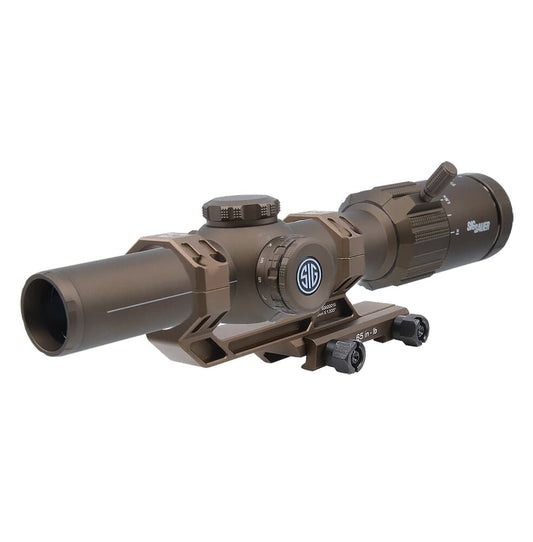

Sig Sauer Tactical Tango-MSR LPVO Rifle Scope - 1-6x24 Illum MSR BDC6 offers a versatile optical system tailored for precision shooting. With a magnification range of 1x to 6x, this scope ensures clear visibility at various distances. The illuminated MSR BDC-6 reticle features 11 brightness settings, adapting seamlessly to changing light conditions. An integrated throw lever facilitates quick magnification adjustments, making it ideal for dynamic shooting environments.
Engineered for resilience, this scope is waterproof, fog-proof, and shockproof, ensuring consistent performance in demanding conditions. Low dispersion glass lenses enhance light transmission, delivering sharp and accurate images even in low-light scenarios. Additionally, the included ALPHA-MSR mount simplifies installation, allowing you to focus on your target without hassle.
Features:
- HIGH PERFORMANCE OPTICS for exceptional clarity in any lighting.
- ILLUMINATED RETICLE with 11 brightness levels for precise targeting.
- QUICK MAGNIFICATION ADJUSTMENT thanks to the integrated throw lever.
- DURABLE CONSTRUCTION ensures reliability in tough environments.
- LOW DISPERSION GLASS offers distortion-free images for ultimate accuracy.
- WATERPROOF & FOG-PROOF performance for all-weather reliability.
- ALPHA-MSR MOUNT INCLUDED for easy and secure installation.
- LIGHTWEIGHT DESIGN minimizes added weight to your firearm.
Technical Specifications Table
| Specification | Details |
|---|---|
| Magnification Range | 1x - 6x |
| Lens Diameter | 24mm |
| Weight | 18.5 ounces |
| Exit Pupil | 4.5mm - 10.5mm |
| Eye Relief | 3.74" - 3.93" |
| Field of View | 124.8 feet @ 100 yards (low power), 19.6 feet @ 100 yards (high power) |
| Reticle Position | Second Focal Plane |
| Scope Tube Size / Mount | 30mm |
What’s in the Box?
- ALPHA-MSR 1 piece aluminum cantilever mount
- Lay flat flip-back lens covers
Customer Reviews
"This scope is a game changer for my AR setup! The clarity is unparalleled." - Jake R.
"The quick magnification changes are a lifesaver during competitions!" - Lisa M.
FAQ
How does the Tango-MSR perform in low light?
The low dispersion glass and illuminated reticle ensure that you maintain clarity even in challenging lighting. This makes it an excellent choice for precision shooting at dawn or dusk.
Is the scope suitable for heavy recoil firearms?
Yes, the Tango-MSR is designed to withstand shock and recoil, ensuring durability during heavy use. It’s built to last, even under the toughest conditions.
Similar Models
Looking for more options? Discover our extensive Sig Sauer lineup, including products like the Sig Sauer Tango6 1-6x24 for enhanced versatility and the Sig Sauer Romeo4T for an advanced red dot experience. Explore our full collection to find the perfect optics tailored for your shooting needs!
You May Also Like
Here’s some of our most similar products people are buying. Click to discover trending style.







